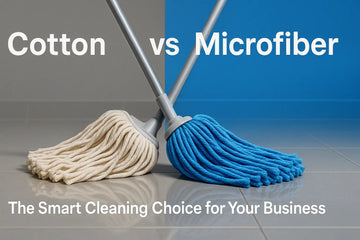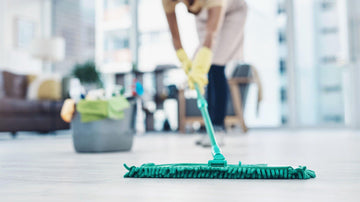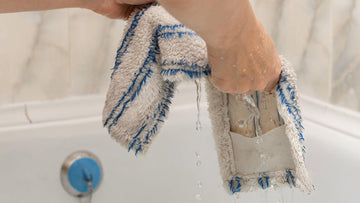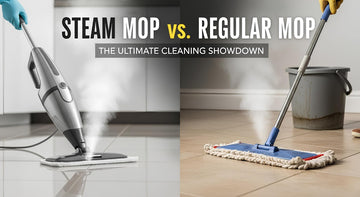Choosing between Cotton String Mops and Microfibre String Mops can impact your cleaning budget. Most facility managers struggle with this decision every day. The wrong choice wastes time and money. You get poor cleaning results and need to replace items often.
Cotton String Mops have dominated commercial cleaning for decades. They offer familiar reliability and lower upfront costs. Microfibre String Mops represent modern cleaning technology with superior performance and efficiency. But which one delivers better value for your specific business needs?
This comprehensive guide examines both options through real-world performance data and business economics. You'll discover which mop type excels in different environments. We'll analyze cleaning effectiveness, durability, and total ownership costs. By the end, you'll know which system gets the most from your cleaning budget. You'll also see how it meets your facility's needs.

Understanding the Fundamentals: Cotton vs Microfibre Technology
What are Cotton String Mops
Cotton mop head construction uses natural cotton fibers woven into traditional string patterns. These fibers absorb liquid through capillary action and natural fiber porosity. Cotton has served as the standard for commercial mop applications for over a century.
Cotton fibers soak up moisture and trap dirt in their natural structure. The twisted string design creates surface area for absorption. However, cotton pushes debris around rather than trapping it effectively. This limitation affects cleaning quality in sensitive environments.
Traditional cotton mop heads are great for soaking up big spills. They also work well for heavy-duty cleaning tasks. They work well with bleach and harsh chemicals that damage synthetic materials. Many facilities pick cotton for regular maintenance. It's easy to handle and costs less upfront.
The natural fiber composition makes cotton biodegradable and environmentally friendly at disposal. The cleaning performance issues and short lifespan cause ongoing challenges for busy facilities.
What are Microfibre String Mops
Microfibre String Mops use synthetic fibers. These fibers are 100 times thinner than human hair. These ultra-fine fibers form millions of tiny hooks. They trap dirt, dust, and bacteria. A microfibre mop is easier to grasp when you know about this advanced fiber technology.
Microfibre mop heads work through electrostatic attraction and mechanical action. The split fibers create positive and negative charges that attract dirt particles. The microscopic size allows penetration into surface pores that cotton cannot reach. This combination delivers superior cleaning performance.
Modern microfibre mop cloths resist bacteria and stay strong after many washes. The synthetic composition allows aggressive laundering without fiber breakdown. This durability translates to long-term value despite higher upfront investment.
Flathead microfibre mop designs optimize contact with floor surfaces. The flat profile distributes cleaning solution evenly while maximizing fiber contact. This engineering approach delivers consistent results across different floor types and cleaning challenges.

Performance Comparison: Cleaning Effectiveness and Efficiency
Dirt and Bacteria Removal Capabilities
Scientific testing reveals dramatic performance differences between mop types. Microfibre String Mops remove 95% of microbes compared to 68% for cotton alternatives (CDC, 2008; ISSA Cleaning & Hygiene Standards, 2019). Microfibre mop heads catch particles in their fibers. They don’t just push debris around. The electrostatic properties attract and hold dirt until washing eradicates it. Cotton fibers lack this trapping ability and often redistribute soil across surfaces.
Cross-contamination studies show microfibre reduces bacterial transfer between areas by 85%. Good mops for floors should stop dirt from spreading. They keep clean areas safe from contaminants. Cotton mops fail this critical test in sensitive environments.
The microscopic fiber size allows microfibre to clean at the molecular level. Floor washing mops clean better with microfibre. The fibers get into the tiny grooves on surfaces. Cotton cannot reach these microscopic spaces effectively.
Absorption and Coverage Areas
Water absorption rates demonstrate another clear advantage for microfibre technology. Microfibre String Mops can hold six times their weight in liquid. This is much more than cotton mops. This superior absorption means fewer trips to rinse and refill buckets. Coverage area per cleaning cycle shows dramatic efficiency gains with microfibre. Cleaning mops for floors made from microfibre clean 400-500 square feet per pass. Cotton mops manage only 100 square feet before requiring bucket changes.
Mop floor cleaning productivity increases significantly with microfibre due to reduced downtime. Facilities report 40% faster cleaning times when switching from cotton to microfibre systems. This efficiency translates directly to labor savings and improved productivity.
Microfibre absorbs well and has excellent coverage. That’s why it’s the best option for large facilities. Industrial mop applications see the most significant gains from these performance improvements. This is due to their scale and operational needs.
Performance on Different Floor Types
Vinyl Composite Tile (VCT) and Luxury Vinyl Plank:
- Microfiber advantages: Fine fibers conform to surface texture, remove embedded dirt from grooves
- Cotton considerations: May skip textured areas, pushes debris into seams
- Recommendation: Microfiber delivers 40% better dirt removal on these surfaces
- Maintenance benefit:Microfiber extends floor finish life by preventing abrasive buildup
Ceramic Tile and Porcelain:
- Microfiber advantages: Penetrates grout lines effectively, removes soap scum and mineral deposits
- Cotton considerations:Cannot reach recessed grout areas, leaves residue behind
- Recommendation: Floor cleaning mops with microfiber heads essential for grout maintenance
- Long-term benefit: Prevents costly grout replacement and restoration
Polished Concrete and Sealed Surfaces:
- Microfiber advantages:Won't scratch delicate finishes, captures fine dust particles
- Cotton considerations: May leave lint and streaks on smooth surfaces
- Recommendation: Microfiber required for maintaining high-gloss appearance
- Safety benefit:Better slip resistance maintenance through effective cleaning
Textured and Non-Slip Surfaces:
- Microfiber advantages: Flexible fibers bend into surface irregularities
- Cotton considerations: Cotton String Mops skip over textured areas, miss embedded dirt
- Recommendation: Microfiber is essential for ADA-compliant slip-resistant surfaces
- Compliance benefit:Maintains required slip resistance ratings through thorough cleaning
Before getting into details, here’s a quick side-by-side breakdown:
| Feature | Cotton String Mops | Microfibre String Mops |
|---|---|---|
| Initial Cost | Low upfront, widely available | Higher upfront, long-term savings |
| Cleaning Efficiency (Bacteria Removal) | ~68% removal (CDC data) | ~95% removal (CDC, ISSA) |
| Durability (Wash Cycles) | 15–30 washes | 150–500 washes |
| Water Absorption | Good (absorbs spills quickly) | Excellent (holds 6× weight in liquid) |
| Best-Suited Applications | Large spills, chemical-heavy cleaning, stripping floors | Healthcare, offices, schools, food service |
| Maintenance | Requires bleach, wears out quickly | Easy care, avoid softeners/bleach, long life |
Application-Specific Use Cases: When to Choose Each Type
Microfibre String Mops
Healthcare facilities demand the superior bacteria removal that Microfibre String Mops provide. Infection control protocols require proven pathogen reduction. The 95% microbe removal rate makes microfibre essential for hospitals, clinics, and medical offices.
Daily maintenance cleaning operations achieve maximum efficiency with microfibre systems. Mops for cleaning large areas benefit from the extended coverage and reduced bucket changes. This efficiency matters most in facilities with tight cleaning windows.
Minimal chemical use areas prefer microfibre. It works well with just water. Microfibre mop spray applications often eliminate the need for traditional cleaning chemicals. This reduction benefits both worker safety and environmental compliance.
Cotton String Mops
Large industrial spills require the heavy absorption capacity that Cotton String Mops provide. Manufacturing facilities that deal with oil, coolants, or large liquid volumes should absorb as much as they can in each pass. Cotton excels in these demanding applications.
Floor stripping operations benefit from cotton's chemical resistance. Cotton mop head materials withstand harsh strippers and solvents that damage synthetic fibers. This durability makes cotton essential for refinishing projects.
Environments with acidic chemicals or bleach solutions need cotton's natural resistance. Commercial mops for labs or chemical processing must be made of materials that resist chemical damage. Budget-conscious routine cleaning operations may choose cotton for basic maintenance tasks. When cleaning quality needs are low, cotton works well. It also costs less to start with.
Industry-Specific Recommendations
Healthcare facilities must prioritize Microfibre String Mops for infection control compliance. The superior pathogen removal capability is not optional in medical environments. Patient safety depends on effective cleaning and disinfection protocols.
Food service establishments benefit from microfibre's ability to reduce cross-contamination. Washable microfibre mop systems support the frequent laundering required by health department regulations. The chemical-free cleaning capability also supports food safety protocols.
Educational institutions typically benefit from microfibre's efficiency and durability. The best cloth for mopping school floors should balance performance and cost. Microfibre's longer lifespan often provides better value despite higher initial investment.

Environmental Impact and Sustainability Considerations
Water Conservation Benefits
EPA studies document significant water usage reduction with Microfibre String Mops (EPA Sustainable Facilities Report, 2015). Traditional cleaning methods use 105 gallons per 100 rooms compared to 5 gallons with microfibre systems. This 95% reduction supports water conservation goals.
Environmental compliance requirements increasingly focus on water usage efficiency. Microfibre dry mop applications eliminate water usage entirely for dust control operations. This capability supports LEED certification and sustainability reporting requirements.
Facilities in drought-prone regions benefit most from microfibre's water conservation capabilities. Southwestern states facing water restrictions value cleaning systems. These systems work well and use much less water. Water treatment costs also decrease with reduced usage. Mop with microfibre head systems generate less wastewater requiring treatment. This reduction affects both municipal fees and environmental discharge considerations.
Chemical Reduction and Safety
Microfibre mop spray applications often eliminate traditional cleaning chemicals entirely. Plain water achieves effective cleaning on most surfaces when combined with microfibre technology. This reduction improves worker safety and reduces environmental impact. Worker safety improvements include reduced chemical exposure and vapor inhalation.
Cleaning microfibre mop heads without harsh chemicals keeps staff safe from health risks. This benefit reduces insurance costs and liability concerns. Indoor air quality improves with reduced chemical usage. Film mops and microfibre alternatives help green building standards. They do this by removing volatile organic compounds from cleaning tasks.
Choosing the Right Size and Specifications
Not all mop heads are created equal — even within cotton or microfibre categories. Selecting the right size and material density depends on your facility type and operational needs:
Facility Size and Layout
- Small offices (under 5,000 sq. ft.) → Standard-size microfibre heads (16–18 inches) are efficient.
- Medium facilities (schools, retail) → 24–36 inch flat microfibre heads cover larger areas quickly.
- Large industrial spaces → Oversized cotton heads may be practical for handling spills.
Weight and Density
- Lightweight microfibre → Best for daily dusting and light cleaning.
- Medium density → Balanced performance for schools, offices, and healthcare.
- Heavyweight cotton → Ideal for stripping floors and chemical-heavy environments.
Application Scenarios
- High-traffic areas → Microfibre excels at quick turnaround and bacteria removal.
- Specialty zones (labs, kitchens, restrooms) → Color-coded microfibre supports hygiene compliance.
- Industrial settings → Cotton remains useful for chemical spills and stripping tasks.
By matching mop type, size, and density to your facility’s layout, you optimize cleaning efficiency and extend product life.
Maintenance, Care, and Operational Considerations
Proper Cleaning and Laundering Techniques
How to clean microfibre mop heads properly extends their useful life significantly. Wash in hot water without fabric softener or bleach. These additives coat the fibers and reduce cleaning effectiveness. Air drying prevents heat damage that reduces fiber performance.
Cotton mop heads require different care protocols. Hot water washing with bleach sanitizes cotton effectively. However, frequent bleaching shortens fiber life and reduces absorption capacity. Balance sanitization needs with equipment longevity.
Avoiding common mistakes can help prevent your mop from needing to be replaced too soon. Using fabric softener on microfibre is a no-no, as it can clog the tiny fibers. Don't wash cotton and microfibre together. Cotton lint sticks to microfibre surfaces.
Taking good care of microfibre can make it last for 150-500 washes. In comparison, cotton usually only lasts for 15-30 washes. This significant difference affects how often you replace your mop and its long-term cost.
Storage and Hygiene Protocols
Commercial storage requires proper ventilation to prevent bacterial growth. Both Cotton String Mops and Microfibre String Mops need complete drying between uses. Damp storage creates odors and reduces sanitary effectiveness.
Color-coding systems stop cross-contamination in different facility areas. Use red mops in restrooms, blue for general areas, and yellow for food service. This keeps hygiene protocols strong. Both mop types support color-coding strategies.
Inventory rotation ensures that older mops are used before purchasing new ones. Microfibre mop cloths last longer, but proper rotation increases their value.
Professional storage systems include ventilated cabinets and organized hanging setups. These investments protect mop performance and extend their lifespan, no matter the material.
Staff Training Requirements
How to use microfibre mop systems effectively requires specific training protocols. Staff must understand proper wringing techniques and solution application methods. Microfibre works differently than cotton and needs adjusted techniques.
Training considerations include proper handling to prevent fiber damage. Microfibre requires gentler treatment than cotton but delivers superior results when used correctly. Investment in training protects equipment investment.
Ergonomic benefits favor microfibre because of reduced physical effort required. The superior cleaning effectiveness means less scrubbing and pressure application. This reduction prevents worker injuries and improves job satisfaction.
Regular training updates keep usage correct. Washable microfibre mop systems often require refresher training. This helps maintain peak performance and extends equipment life.

Making the Right Choice for Your Business
Decision Framework for Facility Managers
Facility type determines primary selection criteria. Healthcare and food service facilities prioritize cleaning effectiveness and bacteria removal. Industrial facilities focus on chemical resistance and absorption capacity. Office buildings balance performance with operational efficiency.
Budget considerations include both initial investment and total ownership costs. Cotton String Mops cost less upfront but require frequent replacement. Microfibre String Mops cost more initially but last significantly longer.
Cleaning frequency affects equipment selection significantly. Daily cleaning operations benefit most from microfibre's efficiency and durability. Weekly or less frequent cleaning may not justify microfibre's higher initial investment.
Assessment checklist should include current cleaning results, staff feedback, and maintenance requirements. Facilities experiencing cleaning quality issues benefit most from upgrading to microfibre systems.
Hybrid Approaches: Using Both Systems Strategically
Situational applications optimize each mop type for specific tasks. Cotton String Mops handle large spills and chemical applications. Microfibre String Mops manage daily maintenance and detailed cleaning tasks.
Inventory management requires planning for different replacement schedules. Cotton mops need replacement every 15-30 wash cycles. Microfibre lasts 150-500 cycles. This difference affects ordering and storage requirements.
Training staff on multiple systems adds complexity but provides operational flexibility. Cross-training fills gaps when some mop types aren't available or fit for specific tasks.
Strategic implementation starts with high-priority areas. Use microfibre in healthcare and food service areas. Cleaning is essential there. Expand to other areas as budget and training allow.
Common Questions and Misconceptions
Many facility managers think Cotton String Mops clean better because they feel more absorbent. However, absorption doesn't guarantee effective cleaning. Microfibre traps dirt more effectively, leading to better results, even if it feels different.
The misconception that microfibre requires special chemicals persists in many facilities. Microfibre mop spray with plain water often outperforms cotton with traditional cleaners. This simplicity reduces chemical costs and storage requirements.
Some managers worry about microfibre's higher initial investment. The break-even point happens at about 150 wash cycles. Most facilities hit this within 6 to 12 months. Long-term savings far exceed initial investment differences.
Concerns about microfibre complexity are often unfounded. How to use microfibre mop systems effectively requires minimal additional training. The performance benefits justify the small learning curve for most operations.
Professional Solutions and Product Recommendations
An effective cleaning program depends on more than choosing cotton or microfibre, it requires planning, training, and proper system design.
1. Match tools to your environment
- Select mop types based on soil load, floor finish, and chemical use.
- Use microfibre for daily cleaning in healthcare, schools, and offices.
- Keep cotton available for stripping, heavy spills, or chemical-intensive tasks.
2. Standardize protocols
- Establish clear cleaning procedures tailored to floor type and traffic.
- Use color-coding (red for restrooms, blue for common areas, yellow for food service) to reduce cross-contamination.
- Rotate inventory so mop heads wear evenly and replacements are predictable.
3. Maintain and monitor
- Launder microfibre separately without bleach or softener; cotton tolerates harsher washing but wears faster.
- Track wash cycles to schedule replacements before performance drops.
- Store all mop heads in ventilated areas to prevent bacterial growth.
4. Train staff effectively
- Demonstrate correct wringing, solution use, and handling for both cotton and microfibre.
- Emphasize ergonomics — microfibre requires less force, reducing strain and injury risk.
- Refresh training regularly to maintain consistent cleaning quality.
By focusing on selection, standardization, maintenance, and training, facility managers create a system that delivers consistent cleanliness, extends mop life, and reduces costs without compromising hygiene standards.
Conclusion
Microfibre String Mops deliver superior cleaning performance, removing 95% of microbes versus cotton's 68%. Healthcare and office facilities benefit most from microfibre's efficiency and bacteria removal. Cotton String Mops remain best for chemical-resistant applications and industrial spill cleanup.
Yocada has been committed to the cleaning industry for 38 years, blending innovation with practical design. Our tools work well and look nice, ensuring better cleaning experiences. Contact our specialists for customized assessment. We'll help you choose the optimal Cotton String Mops and Microfibre String Mops combination that maximizes your investment while delivering the required results.





